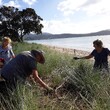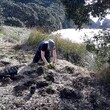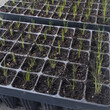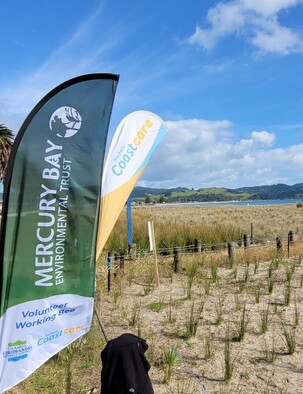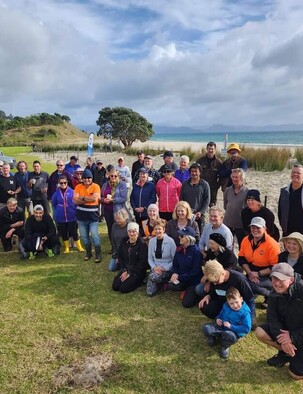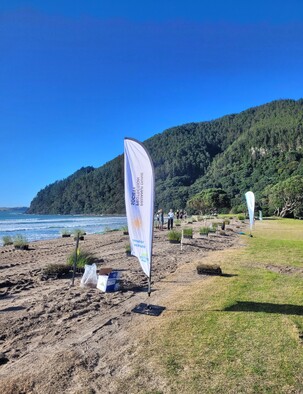SAND DUNE RESTORATION
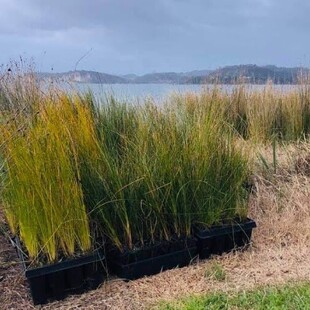
Restoring our sand dunes is essential …
Coastal erosion has been occuring on the Eastern Coromandel beaches for some time. Our coastal margins form a very dynamic environment, where sand moves and dunes grow and recede with time. While it is quite a natural thing to have happen, we often see major damage when there is a storm. With rising sea levels meaning even more erosion in future, growing sand dune plants for restoration projects has become a big part of MBET’s operations.
Native dune plants capture, and help hold the sand in place, so that the dunes are able to restore themselves over time once the plants are established.
We support sand dune restoration on a number of east coast beaches working along side TCDC and Coastcare, helping them run their planting days and providing them with plants grown sourced locally.
We also run a local Beachcare group here in Whitianga. This ia a group of local volunteers who meet every week to undertake weeding, planting and general dune maintenance along Buffalo Beach.
The Importance of Sand Dunes
As another summer cyclone crashes into the east coast of the Coromandel Peninsula, it is a good time to think about just why our sand dunes are important and why we work so hard to restore and protect them.
Our coastal margins, that small strip where the land meets the sea, are an extremely dynamic zone. Extreme weather events, king tides, storm surges, high winds, and also long periods of settled weather, all affect what happens along the coastal margin, and these effects are most clearly seen where the coastal margin is a beach.
Interestingly the effects are often seen most dramatically where a town or city sits directly behind the beach. There are two reasons that this causes a problem. The first is that in the development of the town, the dunes are often flattened out or effectively removed to provide unrestricted sea views, and secondly, because of the proximity of houses or amenities the beach loses the ability to retreat inland in periods of more aggressive erosion. This is known as coastal squeeze, and we see a great example of it here in Whitianga.
Our beaches have been moving inland, and back out towards the sea again for thousands of years. Sand migration is a natural process and it happens within a cycle. The problem is we never know how long the cycle is. It could be 5 years, 20 years or 150 years, but it has always been a cycle. If we happen to be in the middle of a very long cycle we might see the beach retreating inland for our whole lifetime, but that still doesn’t mean the erosion is permanent. The sand is moved away from the beach during storm events, and is deposited on the sea floor offshore. When the conditions change, a favorable set of circumstances may allow that sand to be returned to the beach. Sometimes this happens soon after the storm event, but it may take many many years for the beach to recover.
Paramount to that recovery being successful is a healthy sand dune sitting behind the beach. The dune works as a buffer zone, a body of sand that can and does loose ground to the ocean in storm events, but which can rebuild itself over time after the erosion has taken place.
Just how effective the dune is in rebuilding itself depends on the vegetation that is present, and this is why we are trying to restore the dunes and plant them with the native species that are a critical part of this process. The dune plants we plant, captures the sand that wave action brings ashore, and that the wind blows inland as that sand dries.
Unlike man’s houses, these plants thrive in shifting sands. Plants on the foredune, that is the front of the dune closest to the water, can be completely covered with windblown sand, and they will keep growing and capturing more sand to rebuild the dune. We plant Spinifex and Pingao in this area, and a wide margin of these plants can be seen on any naturally healthy dune system in New Zealand.
Behind this, in the mid-dune zone we find Knobby Club Rush (Wiwi) and Meuhlenbeckia (Pohuehue), which grow taller and help to capture that sand which has blown over the top of the lower growing foredune plants. Ideally behind this we would have taller hardy trees and shrubs in a zone called the backdunes, but a wide coastal margin is needed for this to establish. A great example in our area is the natural dune along the middle section of Otama Beach.
The Spinifex on the foredune sends runners down the beach towards the ocean. These take root and as the plant grows it captures sand and helps grow the dune towards the water. However if the plant is constantly battered by erosion and can’t establish further down the dune, it will turn around and send runners inland, re-establish itself further up the dune, and then begin the process again. In this way the dune can move backwards and forwards over time depending on the prevailing conditions. Dunes have been doing this for thousands of years.
However man has arrived and interfered with the system. Coastal squeeze has meant that we don’t have enough room for a healthy dune to actually do its job. The plants we put along the margins struggle to survive because they don’t have the room they need to move inland and bring the beach with them. People are often critical of the plantings that we do, saying that a few plants will never stop the erosion. But the important point is that we do not plant these plants to stop erosion. We plant these plants so that the dune will be more able to rebuild itself, so that it can recover from the storm events and continue to provide that buffer zone, and that will mean that we will continue to have a beach.
Coastal Restoration
Check out the Coastal Restoration Trust of New Zealand video series about how our dune systems work and why they are important
Introduction
How Beaches Work
Coastal Squeeze
Sea Level Rise
New Approach
Restoring
2023 Plantings
In 2023 we were faced with multiple cyclones which led to beach recovery mode for us. It has been a tough year for our sand dunes, and our amazing dune group volunteers have put a lot of hours into restoring, repairing and weeding our dunes.
Get in touch

Kim
Project Manager
New Zealand’s ecosystems are truly unique, they evolved over millions of years in isolation from the outside world. Since the arrival of man, so much has changed. I don’t think many people realise just how special the New Zealand environment is, and just how much work is required to protect it for future generations.

Geoff
Funding and Finance
If we enjoy our environment we will value it. If we value it we will care for it. If we care for it, it will reward us. Our environment is our life!
Micayla
Project Assitant
Have you ever just listened to the sounds of the forest, they are calling us, and they need our help!
Here at the Mercury Bay Environmental Trust we are taking one step at a time to restore our ecosystems, but we can't do this alone, we need your help!
E: mbenvironmentaltrust@gmail.com
M: +64 27 954 7434
GET IN TOUCH
Mercury Bay Environmental Trust
P. +64 27 282 3369
E. mbenvironmentaltrust@gmail.com
Postal Address
PO Box 5
Whitianga 3510
New Zealand
